Suffrage Songs: Next Election Day by Eugenie M. Ray-Smith (1912)
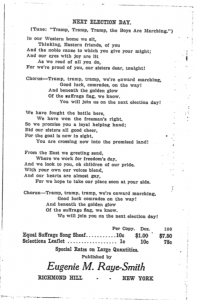
As many other groups in the civil rights movement the Women’s movement also had several songs that exemplified their long hard fight for Women’s rights. This song written in 1912 represented optimism in obtaining voting rights for women. Throughout the fight for women’s rights women’s voices continued to be silenced by white men in power however, music was a way in which women could not be silenced and was a way to amplify their message vocally. This song is a part of a list of songs publishes by Eugine M. Ray-Smith that highlighted both the struggles of the women’s fight and the hopes for the future. Throughout this fight many men continued the belief that women had no place in politics or law. Not only did men believe this but many women did not support the initiatives of the movement. The women in this women faced the constant psychological deconstruction of the misoginistic values that had been embedded in history. Not only did this fight include convincing white males in government to grant women these rights but women also faced the issue of convincing other women and constantly questioning the current patriarchal society.
Margaret Sanger “How Shall we Change the Law” 1917
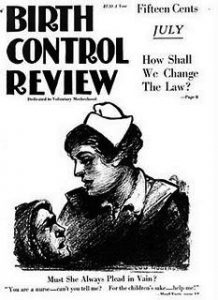
In 1917 Maragaret Sanger, a birth control activists wrote a publication “How Shall we Change the Law” in the New York Women’s Publishing Company Publication. In this publication Sanger collaborated with Mary Dennett another birth control activist who had much different suggestions than sanger. The different approaches reflected the fact that Sanger appears to be more of a radical feminist while Dennett was certainly a moderate feminist. Their premise of disagreement was how much influence the medical industry should have over legislation surrounding birth control. This highlighted another key issue that the medical field was dominated by men who very likely did not support the right to birth control. To gain support, Sanger partnered with the eugenics movement on the premise that birth control would allow for the “fit” humans to have more children and the “unfit” to have less children creating a better breed of humans. Although this was certainly a constructive strategy, it reaffirmed the fact that women had to place their goals in a secondary category to some other objective. In order for Sanger to receive the necessary support, she molded her goals for birth control legislation to fit those of the Eugenics movement which consisted of white anglo-saxon males.
The Great Migration: Leaving the South (1922)
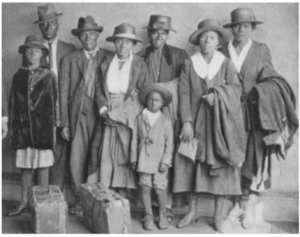
Around the 20’s massive amounts of African Americans began moving from the southern states to the north-east, west and the mid west states to escape the horrors of the south. While this presented several economic opportunities African Americans were not able to escape the traumatic racial horrors of the south. In history, the south has been portrayed as the most racist American territory however, these same incidents persisted in the north. In the 1920’s the KKK resurged and gained several members in northern states such as Pennsylvania. Their message expanded beyond terrorizing African Americans but now included Jews and immigrants. As African Americans hoped to walk away from the terrors of the south the resurgence of white male supremacy seemed to follow all marginalized groups in each effort toward progression.
W. E. B. Du Bois, “Opinion,” The Crisis, 24 (October 1922): 247-53.
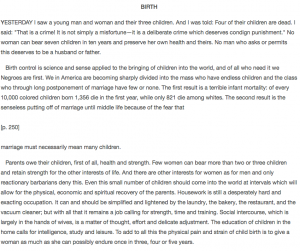
This excerpt from W.E.B. Du Bois’s opinion on birth control highlighted a different narrative of the goals of the birth control movement that spoke specifically to the black community. He delivered his opinion to the National Association for the Advancement of Colored People in October of 1922. This six page opinion included an assessment of how birth control would uniquely impact the black community. He specifically highlighted the effects it could potentially have on marriage, children, birth childhood and education. The above excerpt includes his thoughts on how the lack of birth control impacts birth and the family as a whole. Du Bois’s efforts helped shape the creation of the Harlem Branch Birth Control Clinic and allowed white birth control activists and African American professionals to come together. This Clinic symbolized the power that can evolve from marginalized groups joining forces. Although both African Americans and women’s rights laid at the hands of white men, the collaboration of these two populations reinforced how much power that people do have despite who the decision makers are.
White Man’s Burden (1899)
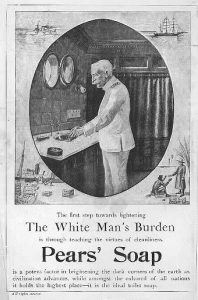
This ad for Pear’s soap in 1899 exemplified the true feelings and beliefs that were held by many white men during this time. Although not as blatant, remnants of these beliefs are continuously upheld even in today’s society by white men across all lifestyles. The “White man’s Burden” refers to the duty of wholesome white men to cleanse colored people. The idea of “cleansing” had a direct relation to colonization in terms of stripping individuals of their previous cultures and practices. Each aspect of this add is strategically designed to portray the white male as a savior to all American citizens and that this is not a choice but an unfortunate duty that was bestowed upon them. The man in this image is dressed in all white and having white hair allowed him to closely model a god like character. In the background of photo lies many smaller images. One of the images includes what appears to be a slave lifting their hands to a white man in praise suggesting that black people should be thankful for that white men do for them. This message was not only for people of color but was also used to re-affirm to white women and poor whites the heroic nature and power of being a white man, despite the progressive changes that happened in American society.
